 |
|

|
 |
TABLE of CONTENTS
 |
Minnesota 20-year State Highway Investment Plan now available online |
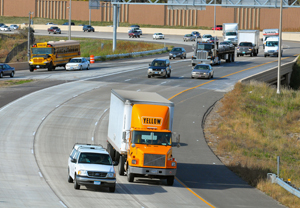
MnSHIP is a 20-year plan that details projects for the next seven years and provides broad investment priorities through 2033. Photo by David Gonzalez |
After months of work and public input, MnDOT Dec. 23 released the latest long-term highway investment plan, which details projects for next seven years and provides broad investment priorities through 2033.
The Minnesota 20-year State Highway Investment Plan, or MnSHIP, connects the Minnesota GO 50-year vision and policies established in the Statewide Multimodal Transportation Plan to capital improvements on the state highway system.
“This plan is the result of extensive collaboration among MnDOT, residents, stakeholders and partners throughout Minnesota,” said Commissioner Charlie Zelle. “The success of Minnesota’s transportation system depends on the coordinated efforts of many public and private providers. The investment priorities outlined in MnSHIP provide a framework for MnDOT’s contribution to those efforts.”
MnSHIP establishes priorities for spending projected capital revenue on the state highway system, a 12,000-mile network that plays a critical role in supporting the state’s economy and quality of life. MnSHIP is a fiscally constrained plan, meaning its planned expenditures must align with expected revenues, which total $18 billion. Meanwhile, projected transportation needs on the state highway system during the next 20 years total $30 billion.
MnDOT considers many factors when setting priorities, including federal and state law, system conditions and public input. Priorities for the next 10 years balance preservation of existing roads and bridges with investments in safety, new connections for multiple modes of transportation, and other projects that advance economic development and quality of life objectives. Investments in the second 10 years focus almost exclusively on preserving existing infrastructure. Even with this focus, the number of roads and bridges in poor condition will more than double, and perhaps triple, within 20 years.
“The investment priorities in MnSHIP illustrate the increasing constraints on highway planning in Minnesota. Growth in construction costs continues to outpace growth in revenue and, as the highway system ages, needs are increasing,” Zelle said. “In particular, investments in the second 10 years do not address many system needs.”
MnSHIP also outlines the targeted actions and strategies MnDOT will pursue to stretch available revenue and how MnDOT will seek to leverage available revenues to achieve multiple purposes.
“MnDOT will continue to explore innovative methods to use funds efficiently,” Zelle added. “With our partners, we can continue to build and maintain a multimodal transportation system that achieves the Minnesota GO Vision.” |
 |
|

|
 |
TABLE of CONTENTS
 |
New research projects announced |
By Nick Busse and Shannon Fiecke, Research Services & Library

One of the new research projects will evaluate the safety and mobility of two-lane roundabouts. This roundabout is at the Hwy 61 southbound exit at Jamaica Ave in Cottage Grove. Photo by David Gonzalez |
New research projects will explore the possibility of predicting crashes using traffic signal data, using GPS technology to improve worker safety and other issues.
MnDOT’s Transportation Research Innovation Group and the Local Road Research Board announced funding for 24 new research projects for fiscal year 2015. A full list of the approved projects, including brief descriptions of each project proposal, is available on the joint MnDOT-University of Minnesota Crossroads blog at mntransportationresearch.org.
“All of these research projects started as ideas submitted by MnDOT or city and county practitioners who are looking to address a problem in their respective fields,” said Linda Taylor, Research Services & Library director. “That’s what the research program is here to do.”
Each year, Research Services & Library staff and the LRRB solicit ideas for new transportation research. MnDOT-submitted ideas are reviewed by the TRIG, which is made up of district engineers and office directors, while the LRRB reviews ideas submitted by local agencies. MnDOT staff with ideas for future transportation research projects can submit them at any time via the Minnesota Transportation Research Collaboration Website.
A few highlights of this year’s approved projects include:
- Development of a crash prediction model that uses high-resolution traffic signal data from loop detection systems, such as the SMART-Signal System.
- Creation of a GPS-based construction worker safety system to provide construction vehicle operators and drivers with better situational awareness of the locations of workers.
- Study of safety effects of improvements made to Interstate 35W under the Urban Partnership Agreement.
- Assessment of the economic impact and health benefits of bicycling in Minnesota.
- Evaluation of the lifecycle costs of pavements using recycled concrete aggregates as compared to that of conventional concrete pavements.
- Development of culvert design guidelines to improve habitat for the endangered Topeka shiner minnow.
This video demonstrates a prototype wireless, solar-powered intersection conflict warning system being developed in Minnesota. The so-called "ALERT System" is designed to help drivers at rural, two-way stop intersections identify safe gaps in the cross-traffic and avoid collisions. Video produced by MnDOT Research Services & Library |
|
 |
|

|
 |
TABLE of CONTENTS
 |
Robin Sylvester named new director for Office of Administration |

Robin Sylvester is MnDOT's new Office of Administration director. Photo by Rich Kemp |
Robin Sylvester has accepted the Office of Administration director position, effective Nov. 20. Sylvester comes to MnDOT from the Department of Corrections, where she was the budget director. She has worked for the several state agencies during her 16 years of state service, including Corrections, Human Services, Department of Military Affairs and Bemidji State University.
“Robin comes to us with considerable relevant experience from other state agencies,” said Sue Stein, Corporate Services Division director. “She is a great addition to MnDOT and I’m excited to have her join us.”
In addition to a strong financial background, she has experience in facilities management, process improvement, workers’ comp, materials management, emergency management and IT. Sylvester holds a B.A. in Business Management from Concordia College in St. Paul. |
 |
|

|
 |
TABLE of CONTENTS
 |
Salt is main ingredient in MnDOT’s winter maintenance work |
By Sue Roe
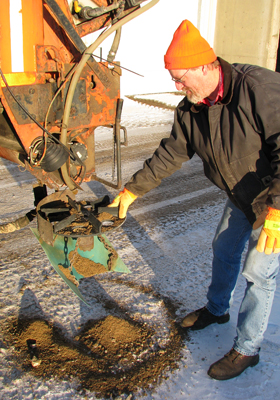
Scott Rennecke, District 4 maintenance, inspects the spinner on one of the trucks. The spinner rotates salt or sand from the truck box onto the road. The winter blast this past week has resulted in more sand being used than salt because of the low temperatures. Salt is most effective when the temperature is between 20 and 30 degrees. Photo by Jerimiah Moerke |
Editor's note: This is a two-part series about the use of salt on roadways, when and how it is used and what measures MnDOT takes to minimize the risks to the environment.
To provide safe winter driving conditions and maintain mobility during winter storm events, MnDOT uses several strategies and materials to help keep roads clear. Salt, or sodium chloride, is the main and most effective ingredient in most of those methods.
Anti-icing is the first line of defense and is used before a storm to prevent the formation of frost and the bonding between snow and ice and pavement. This allows plows to scrape off compacted ice and snow more easily. Anti-icing chemicals are primarily used in liquid form.
Plowing is the next strategy used to remove snow and slush from roadways, but clearing roads to bare pavement involves using de-icing materials that chemically break the bond between ice and the pavement. Salt is the most commonly used de-icer because it is effective, readily available and relatively inexpensive. De-icing is mostly granular salt or with liquid added. Last winter season, MnDOT used 304,555 tons of salt, more than any other material, to clear roads.
Salt works by lowering the freezing point of water and is most effective when used in temperatures between 20 and 30 degrees, according to Kathleen Schaefer, who trains snowplow operators on the use of chemicals. At temperatures colder than 15 degrees, the cutoff for straight salt applications, there isn’t enough moisture present for salt to melt ice and wet pavements can refreeze. That’s when alternative chemicals and methods are used.
“One effective technique is to pre-wet salt with a liquid de-icing chemical and apply it to snow covered roads,” Schaefer said. Pre-wetting helps salt stick to the surface better than dry salt. Pre-wetting also activates the salt more quickly, jump-starting the melting process. Common pre-wetting liquids include salt brine, calcium chloride and magnesium chloride.
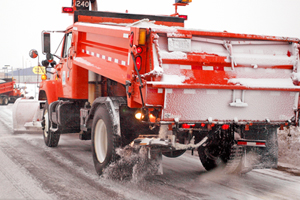
A snowplow distributes salt to de-ice after a snowfall. Photo by David Gonzalez |
Whatever form of salt used, its effectiveness is directly related to the surface temperature of a snow or ice covered road. One pound of salt can melt 46 pounds of ice at 30 degrees but only 8.6 pounds at 20 degrees, said Ryan Otte, maintenance research program administrator. And the longer salt has to react, whether used by itself or with another de-icing chemical, the greater amount of melting occurs.
The type of storm and weather dictate what approach MnDOT uses to remove and melt snow, slush and ice. Several factors, including air temperature, humidity levels, dew point temperatures, type and rate of precipitation, timing of the application and road surface type, are all used to determine which method will work best.
While chemicals effectively melt ice and snow, sand is used to provide traction. Sand is combined with salt to keep it workable or mixed with a liquid de-icing chemical just before spreading to embed the sand on icy pavement. Sand is most often used in very cold temperatures when chemicals lose their effectiveness, Schaefer said. It’s applied at hazardous locations; such as curves, intersections, railroad crossings and inclines. Last winter, MnDOT used 44,327 tons of sand on state roadways.
Part 2 will look at the environmental impacts of salt usage and what MnDOT does to minimize that impact. |
 |
|

|
 |
TABLE of CONTENTS
 |
Accessibility tips – Creating accessible Word documents |
|
By Becky Dahlberg

Judy Evers, District 6 Administrative Support supervisor, works with Microsoft Word in the Rochester office. Photo by Autumn Wright |
If you use Microsoft Word to communicate with others, then these tips are for you. Creating an accessible document that everyone can read and understand is important, whether you’re typing up notes from a meeting or modifying an annual report. Here are a few of the basic elements to keep in mind:
- Heading styles – Use Microsoft Word’s heading styles to format your content and help organize it into sections. Start with a title style - and a subtitle, if your title is long or you want to break it into two parts - and then apply heading 1 to the top of the first section, heading 2 to the top of the first subsection, and so on to format your document. This helps readers visually assess a page at a glance and it helps visually impaired people use a screen reader to do the same type of thing and skip from heading to heading rather than be forced to read through an entire block of unstyled text. It also helps you as the author to organize content into sections that automatically format, so you don’t need repeated spaces to control position. It also forces you to think about appropriate headings to describe each section if you hadn’t already done so.
- Alt text – Use alternative text, or alt text, on all images or objects within the document to help describe them to people using screen readers. Simply right click on the image or object and click “format picture” to enter a title and description. The title and description can be as brief or extensive as needed, depending on the complexity of what you’re describing. Don’t forget to format the images so that they’re in line with text and, therefore, accessible by a screen reader.
- Column header rows in tables – In addition to using alt text to describe a table, using clear column headings can provide context and help a person navigate the table’s contents. To specify a header row in a table, click anywhere in the table, and on the table tools design tab, in the table style options group, select the “header row” check box.
- Meaningful hyperlink text – Use a screentip, text that appears when your cursor hovers over a hyperlink, to add context to those hyperlinks in almost the same way you’d use alt text to describe images. Simply place your cursor in the hyperlink, and on the insert tab, in the links group, click “hyperlink” to open the hyperlink dialog box. Then click “screentip” and type in your text to describe the link. This description can be as brief or extensive as needed, depending on what you’re describing.
For more Microsoft Word accessibility tips, visit the Communications accessibility resources page. Do you have a question about accessible documents or other forms of communication? We want to hear it! Email webteam.dot@state.mn.us to share your thoughts. |
 |
|

|
 |
TABLE of CONTENTS
 |
Employees give generously during the holidays |
By Rich Kemp
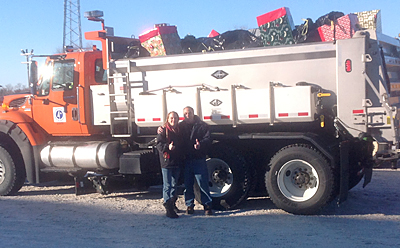
Mindy Heinkel and Cliff Gergen, organizers of the toy drive in the Metro District, stand in front of a truck loaded with toys for the Toys for Tots program. Photo by John Bieniek |
The holiday season is a time for giving and MnDOT employees statewide came through again this year. They donated food, toys and money to different charities to make a difference in many lives. Here’s a look at some of the efforts around the state:
District 1
Duluth employees donated toys during a drive for the Toys for Tots program.
District 2
Employees in District 2 helped raise $2,191.50 during several events. They volunteered to help with Paul Bunyan Broadcasting’s Radiothon to End Child Abuse, several events to help raise money for the Bemidji Community Food Shelf and a holiday fundraiser event that included a silent auction, gift cards and a family giving tree.
“D2 employees have always been very generous in raising money for local charities such as the food shelf, homeless shelters and local nursing homes,” said Staci Cann, District 2 wetlands specialist. “We all play a huge part with helping others and D2 employees have always shown the true meaning of Christmas.”
District 3
St. Cloud employees donated 58 toys and $1,049 for Toys for Tots. The Baxter office donated toys and $770 for children in the area.
District 4
The 19th Annual Hospice Charity Potluck raised $2,339 for Hospice of the Red River Valley. Since the district started hosting the event in 1995, $22,115 has been raised for Hospice. Current and former employees donate a variety of items for the potluck and charity drawing, many of them handmade.
Metro District
Employees at 23 Metro locations collected more than 3,000 pounds of toys for area children and families. Before delivering the toys, Mindy Heinkel, Metro maintenance, appeared on the KARE 11 newscast to announce the employee effort.
District 6
Offices in Owatonna, Rochester and Winona were official drop-off sites for the U.S. Marine Corps Toys for Tots drive. District 6 has been collecting toys for 11 years. All donations collected stay in southeastern Minnesota, which makes it a great way to give a back to the community.

From left: District 7 employees Chris Hanson, Mike Meffert and Steve Schoeb volunteered to ring the bells for the Salvation Army Red Kettle program in Mankato. Photo courtesy of District 7 |
District 7
Employees volunteered to ring the bells for the Salvation Army Red Kettle program, participated in State Patrol District 2200 Toys for Tots drive and collected food for the Echo Food Shelf during the Mankato Headquarters Christmas potluck.
District 8
During the holiday party, employees donated toys and money to Salvation Army Toys for Kids Drive.
"I was so pleased with the amount of toys and money that was raised for our local Salvation Army Toys for Kids Drive," said Judy Jacobs, D8 Toy Drive coordinator. "Thanks to the support from employees and retirees."
Central Office
Led by Jarvis Keys, Central Office employees donated 430 pounds of non-perishable goods and $60 in cash donations to the Second Harvest Heartland. Employees donated more than 100 hats, mittens and socks for Mary’s House, a community based organization that provides transitional housing services, shelter and support programs to homeless and struggling families. The Office of Financial Management had its 3rd Annual Holiday Fundraiser and raised $1,055.00 for St. Jude’s and Gillette Children’s Hospital.
Bridge Office
Oakdale employees donated prizes and raised more than $1,500 from an auction for the Second Harvest Heartland.
“Even though we all have very busy workloads, it is still important to take few hours out of our work schedules each year to help others in need,” said Cann.
|
 |
|

|
 |
TABLE of CONTENTS
 |
Tools on the Web - News release page |
By Libby Schultz
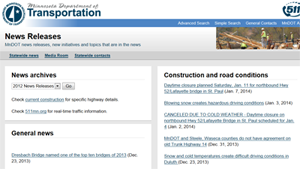
MnDOT news releases can be found on the website under Traveler Information. |
Ever wonder where to find out about project open houses, ribbon cuttings or breaking news about MnDOT projects?
The MnDOT News Release webpage is a good place to start. Every news release issued by MnDOT is put on MnDOT’s public page, a helpful tool for both the public and employees.
“I find the news release page helpful when I’m looking for updates on projects and whether or not there has been an open house for that project,” said Cindy Carlsson, Government Affairs.
The news release page is on the MnDOT homepage under “Traveler Information.” The releases are listed in three categories: News archives list releases back to 2003; General news covers project open houses, awards, transportation programs and miscellaneous topics; and Construction and road conditions contains the latest project information news.
Visit www.mndot.gov/news.html to see more. |
 |
|
| |
|



